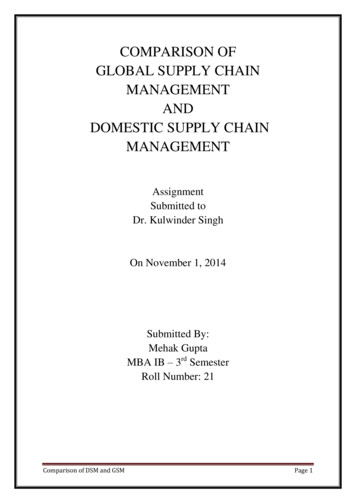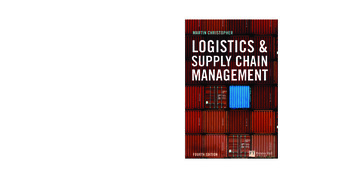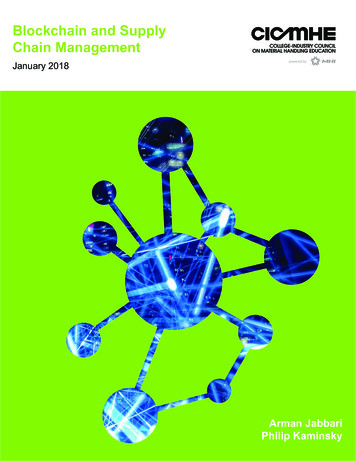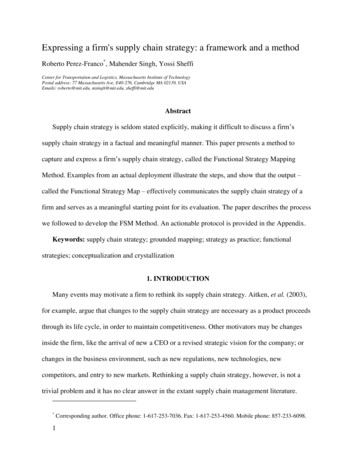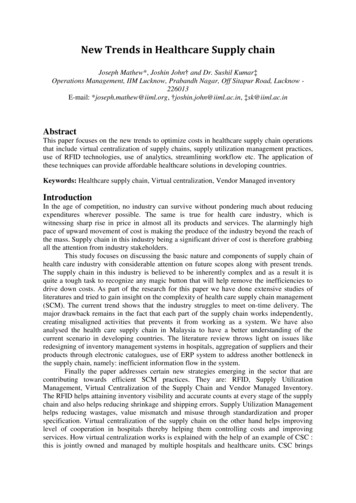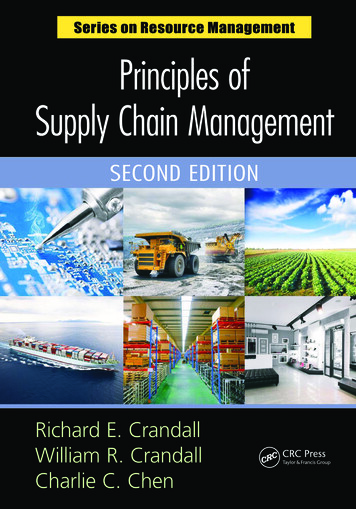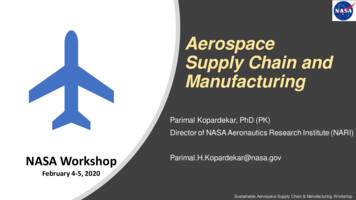
Transcription
AerospaceSupply Chain andManufacturingParimal Kopardekar, PhD (PK)Director of NASA Aeronautics Research Institute (NARI)NASA WorkshopFebruary 4-5, 2020Parimal.H.Kopardekar@nasa.gov
WelcomeWorkshop purposeOutlineCurrent Gaps and ChallengesOpportunitiesCollaboration and next stepsSustainable Aerospace Supply Chain and Manufacturing2
Cycle Time and Production RatesWelcomeGrateful for your passionaround one of the largestbarriers in aerospaceSustainable Aerospace Supply Chain and Manufacturing3
Supply Chain BasicsSupply chainconsists of allparties involved,directly orindirectly, infulfilling a customerneedAerospacesupply chain isan ecosystem ofdifferent porters,warehouses, etc.Supply chainmanagementrefers tocoordination ofall activities4
Supply chain impacts entire life cycle from early conceptualdesign to high volume manufacturing All types of aircraft in all phases Maintenance, repair, and overhaul Skills and talentsSustainable Aerospace Supply Chain and Manufacturing5
Boeing Pratt Whitney Airports Vimana Robotics ZiplineJob Search Joby Aviation Collins Aircraft Propeller Services Many more 75000 jobs for all industries
Boeing and Airbus: 1600 Basic Statistics onManufacturingGeneral Aviation (piston, turboprop,business jets): 2000Rotocraft: 1020Cars: 70M (OICA, 2018)Sustainable Aerospace Supply Chain and ManufacturingCars in US: 2.8M7
ConventionalAircraftSustainable Aerospace Supply Chain and Manufacturing8
Current Situation( 800 B backlog) Boeing and Airbus havebackorders ( 5000 , with 55/month rate) Boeing delivered 806 aircraftand Airbus 800 in 2018 Airbus 863 (2019, 7% up) In 2016, Boeing had 5715undelivered orders and Airbushad 6874Sustainable Aerospace Supply Chain and Manufacturing9
Challenges Casings and forging Composites Auxiliary Power Units Printed Circuit Boards Actuators Software High volume manufacturingand assembly methods Many othersSustainable Aerospace Supply Chain and Manufacturing10
Supply Chain Considerations and Challenges(Credit: EY – A&D Edge, Supply Chain Management in Aerospace and Defense, Feb 2018, slides 8-9)Design andEngineeringPlanningProcurementManufacturing AftermarketConsiderations TimelineCostQualityMarginIPEfficiency Forecastaccuracy Supplydisruptions Demandshifts Inventory Supply chainvisibility Lead times Supplierperformance Pricevolatility Cost andprices Lead times Supplier duediligence Challenges Dependence on large number of sole-source suppliersLong lead timeFinancial challenges across the supply chain for new programsLarge inventory needsCollaboration across complex supply chainCyber and SafetyVolume Ground time On-timedelivery Network Safety11
Dependenceon solesourcesuppliersLong tionacrosssupply ighModerateHighHighModerateMonitor le sourcingHighModerateStrategyAdoption of digitaltechnologiesHighModerateHighReadiness assessmentHighHighModerateLocal players in supplynetworkHighModerateModerateLowCredit: EY – A&D Edge, Supply Chain Management in Aerospace and Defense, Feb 2018)12
Similar challengesfor electric orhybrid, supersonic,and hypersonicaircraft – may beeven worseSustainable Aerospace Supply Chain and Manufacturing13
DronesSustainable Aerospace Supply Chain and Manufacturing14
ConventionalAircraft MarketSustainable Aerospace Supply Chain and Manufacturing15
Summer Internship Project:Hard to find all suppliesquickly that will satisfy NASAand other government needs
Drone industry needssustainable supplychain andmanufacturingcapabilities
Vertical Take-offand LandingSustainable Aerospace Supply Chain and Manufacturing18
NeedsMany calls, texts, and interactionsabout looking for suppliers andmanufacturersNeed suppliers for entire life cycle:Design to high volume manufacturingOvermoldingActuatorsElectric motorsPropellersCastingMany other components andmanufacturing needsSustainable Aerospace Supply Chain and Manufacturing19
OEMTier 1Tier 2Tier 3EngineMechanicalPartsAccessoriesLanding GearWheels &BrakesBearingsWingsFlight ControlActuatorsPlastic Parts &CastingsFuselageAvionics &HydraulicsInterior & InFlightEntertainmentAircraftManufacturer OEM – Control design, manufacturing and assembly function, the most critical component of value chainTier 1 – Support Primes by providing them with equipments and systems like engines, Wings, FuselageTier 2 – Manufacture and develop parts as per the specifications provided by primes and Tier 1 suppliersTier 3 – Responsible for supplying basic products, components and other non-core value added servicesSource: caping/Research%20Report Aerospace%20-%20Supply%20Chain%20Overview.pdf 20
Opportunity to createa tiered system foreVTOLsSustainable Aerospace Supply Chain and Manufacturing21
Global industry: 80 BillionMaintenance,Repair andOverhaul (MRO)MarketSustainable Aerospace Supply Chain and Manufacturing Network neededfor eVTOLS22
OutlookNeed sustainable supplier, manufacturer, and MRO networkCar companies are entering aero industryNeed to understand the productioncertificate, and aviation grademanufacturing needsSustainable Aerospace Supply Chain and Manufacturing23
Putting it all together24
Limited/sole sourcesCurrent Stateof the Art:RiskArchetypes Fragile supplier and market Capacity constrained supply market Foreign dependency Diminishing manufacturing sources andmaterial shortages Gap in U.S. human capital Product security25
Executive Order Assessing and strengthening themanufacturing and defense industrialbase and supply chain resiliency of theUnited States Executive order 13806, September 2018 Decline of U.S. manufacturingcapabilities and capacities Competitiveness Diminishing STEM and trade skills
Many suppliersFew suppliersSupply ChainStrategiesVertical IntegrationJoint VenturesReference: OperationsManagement, Heizer et al(2016)Horizontal IntegrationKeiretsu Networks (part collaboration, part fewsuppliers, part vertical integration)Virtual Companies27
Known Aero Supply Chain Related Issues(California Manufacturing Network, 2018)Sourcing of raw materials – aluminum, steel, copper, etc.Mitigating supply disruption risks (e.g., geopolitical considerations)Coping with Modernization and Emerging Technologies (e.g., wiring problems,software issues, late deliveries of lavatories)Shortage of skilled workers (Tim Cook’s view on outsourcing)28
Time to start building an entire neweco-systemRecommendations:Supply Chain forUrban Air MobilityVehiclesTake advantage of other manufacturing(e.g., auto)Rebuild/train auto, heavy industries,traditional aerospace suppliers toconsider VTOLGet regional manufacturing and supplychain associations exposed toemerging aero needs29
PrototypesBuild an electronicexchange platform toconnect VTOL customerswith suppliersRecommendations:Supply Chain forUrban Air MobilityVehiclesJob productionMass productionQuality management based onFAA production needTraining workforce: curriculum, skills, andentrepreneursEstablish tiered systemEstablish MRO network30
Convert non-aero suppliers andmanufacturesImmediateSuccess:Grow emergingaerospaceecosystemExpand current aero suppliers andmanufacturers in new areasSee opportunity and identify areas tocontributeCreate a tired system and electronicplatform for eVTOLsSustainable Aerospace Supply Chain and Manufacturing31
Build supply chain and manufacturing base for aeroneeds – particularly for emerging vehiclesSupport OEMs with supplier and manufacturing baseand MROsConclusionsIncrease production rate and delivery as comparedwith today’s aerospace manufacturing and assemblystate of the artParts access will need to be rapid for MROsBuild electronic platform with authenticated parts andcertified supplier and manufacturer baseTime to rebuild skills, talents, digital enterprise andattract new manufacturers to scale deliveries32
tainable Aerospace Supply Chain and Manufacturing33
BACKUP34
Scalability is Fundamental Need for UAM Many pilots (or acceptable and reliable autonomy) Spectrum availability Airspace operations (e.g., Unmanned Aircraft System TrafficManagement type construct) Acceptable noise Mass production of electric or hybrid VTOLs Infrastructure (including recharging systems)35
Mass Production of VTOL Vehicles Production rates need to be closer to cars than conventional aircraft Manufacturing and assembly methods Supply chain network and ecosystem36
Current State of the Art in Aero Supply ChainReference: Airbus’ Global Market Forecast, Future Journeys 2013 - 2032 Air Traffic is expected to DOUBLE in the next 15 years The number of passengers is predicted to rise from 2.9B in 2012 to6.7B by 2032 The passenger fleet will grow by 109% from 2012 – 2032 Rising from 16,093 to 33,651 aircrafts37
Current State of the Art in Aero Supply Chain Boeing and Airbus have backorders ( 5000 , with 55/month rate) Boeing delivered 806 aircraft and Airbus 800 in 2018 In 2016, Boeing had 5715 undelivered orders and Airbus had687438
Current State of the Art in Aero Supply ChainReference: Oliver Wyman Global Fleet & MRO Forecast Commentary 2019 2029 In 2017, the U.S. accounted for 49% of the global aerospaceindustry The future growth in aviation will be concentrated in Asia and thedeveloping world, particularly China and India By 2035, the Civil Aviation Administration of China projects thenumber of airports in the nation will double By the end of the decade, China will become the biggest globalmarket for air travel and Asia will be the new center of globalaviation activity39
Current State of the Art in Aero Supply ChainReference: McKinsey Quarterly The Growing Role of Emerging Markets inAerospace Due to globalization, the Western companies will capture short-termcost-reduction opportunities This provides opportunity to refocus resources and capabilities onhigher-value activities (specialization of the industry’s supply chain) E.g. develop the next clean-propulsion technology or compositeassemblies40
Dependenceon solesourcesuppliersLong tionacrosssupply ighModerateHighHighModerateMonitor le sourcingHighModerateStrategyAdoption of digitaltechnologiesHighModerateHighReadiness assessmentHighHighModerateLocal players in supplynetworkHighModerateModerateLowCredit: EY – A&D Edge, Supply Chain Management in Aerospace and Defense, Feb 2018)41
Supply Chain Considerations and Challenges(Credit: EY – A&D Edge, Supply Chain Management in Aerospace and Defense, Feb 2018, slides 8-9)Design andEngineeringPlanningProcurementManufacturing AftermarketConsiderations TimelineCostQualityMarginIPEfficiency Forecastaccuracy Supplydisruptions Demandshifts Inventory Supply chainvisibility Lead times Supplierperformance Pricevolatility Cost andprices Lead times Supplier duediligence Challenges Dependence on large number of sole-source suppliersLong lead timeFinancial challenges across the supply chain for new programsLarge inventory needsCollaboration across complex supply chainCyber and Safety Ground time On-timedelivery Network Safety42
Supply Chain Considerations and Challenges (Credit: EY –A&D Edge, Supply Chain Management in Aerospace and Defense, Feb 2018, slides 8-9) 11 Design and Engineering Planning Procurement Manufacturing Aftermarket Considerations Timeline Cost Quality Margin IP Efficiency Fo

